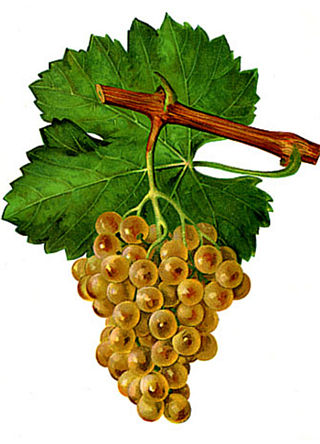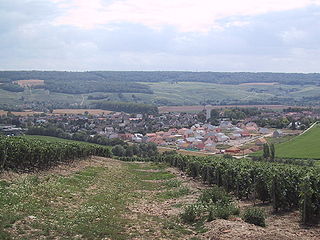
A vineyard is a plantation of grape-bearing vines, grown mainly for winemaking, but also raisins, table grapes, and non-alcoholic grape juice. The science, practice and study of vineyard production is known as viticulture. Vineyards are often characterised by their terroir, a French term loosely translating as "a sense of place" that refers to the specific geographical and geological characteristics of grapevine plantations, which may be imparted to the wine itself.

Malbec is a purple grape variety used in making red wine. The grapes tend to have an inky dark color and robust tannins, and are known as one of the six grapes allowed in the blend of red Bordeaux wine. In France, plantations of Malbec are now found primarily in Cahors in South West France, though the grape is grown worldwide. It is also available as an Argentine varietal.

The Carménère grape is a wine grape variety originally planted in the Médoc region of Bordeaux, France, where it was used to produce deep red wines and occasionally used for blending purposes in the same manner as Petit Verdot.

New World wines are those wines produced outside the traditional winegrowing areas of Europe and the Middle East, in particular from Argentina, Australia, Canada, Chile, Mexico, New Zealand, South Africa and the United States. The phrase connotes a distinction between these "New World" wines and those wines produced in "Old World" countries with a long-established history of wine production, essentially in Europe, most notably: France, Italy, Germany, Spain and Portugal.

Sémillon is a golden-skinned grape used to make dry and sweet white wines, mostly in France and Australia. Its thin skin and susceptibility to botrytis make it dominate the sweet wine region Sauternes AOC and Barsac AOC.

Mourvèdre is a red wine grape variety grown in many regions around the world including the Rhône and Provence regions of France, the Valencia and Jumilla, Bullas and Yecla denominaciones de origen (DOs) of Spain, as well as the Balearic Islands, California and Washington and the Australian regions of South Australia and New South Wales, plus South Africa. In addition to making red varietal wines, Mourvèdre is a prominent component in "GSM" blends. The variety is also used to make rosé and port-style fortified wines.

French wine is produced all throughout France, in quantities between 50 and 60 million hectolitres per year, or 7–8 billion bottles. France is one of the largest wine producers in the world, along with Italian, Spanish, and American wine-producing regions. French wine traces its history to the 6th century BCE, with many of France's regions dating their wine-making history to Roman times. The wines produced range from expensive wines sold internationally to modest wines usually only seen within France such as the Margnat wines of the post-war period.
Wine lake is a cultural phrase referring to the phenomenon of perceived overproduction of wine in the European Union. The phenomenon first came in perception & persistence around the mid-1980s and reemerged in the mid-2000s as a significant issue. The EU's Common Agricultural Policy contained a number of subsidies for wine producers, leading to a supply glut. This surplus forced an overhaul of EU farm policies.

The Champagne Riots of 1910 and 1911 resulted from a series of problems faced by grape growers in the Champagne area of France. These included four years of disastrous crop losses, the infestation of the phylloxera louse, low income and the belief that wine merchants were using grapes from outside the Champagne region. The precipitating event may have been the announcement in 1908 by the French government that it would delimit by decree the exact geographic area that would be granted economic advantage and protection by being awarded the Champagne appellation. This early development of Appellation d'Origine Contrôlée regulation benefitted the Marne and Aisne districts to the significant exclusion of the Aube district which included the town of Troyes—the historic capital of the Champagne region.
The glossary of wine terms lists the definitions of many general terms used within the wine industry. For terms specific to viticulture, winemaking, grape varieties, and wine tasting, see the topic specific list in the "See also" section below.
Plantet is a red wine grape variety that was one of the hybrid grape created by French physician and grape breeder Albert Seibel. While the exact parentage of the grape is unknown, the most popular theories has it as a cross of two Seibel grapes, Seibel 867 x Seibel 2524 with another theory speculating that Plantet's parentage was Seibel 4461 crossed with Berlandieri-Jacquez.
Villard grapes are French wine hybrid grape created by French horticulturist Bertille Seyve and his father-in-law Victor Villard. They include the dark-skinned Villard noir and the white-wine variety Villard blanc with both being members of the Seyve-Villard grape family. Villard noir is a cross of two other French hybrids, Siebel 6905 and Seibel 7053 created by physician and viticulturist Albert Seibel. Like Villard noir, Villard blanc was produced as a crossing of two Seibel grapes, in this case, Le Subereux and Seibel 6468.

California wine production has a rich viticulture history since 1680 when Spanish Jesuit missionaries planted Vitis vinifera vines native to the Mediterranean region in their established missions to produce wine for religious services. In the 1770s, Spanish missionaries continued the practice under the direction of the Father Junípero Serra who planted California's first vineyard at Mission San Juan Capistrano.

Ancient Rome played a pivotal role in the history of wine. The earliest influences on the viticulture of the Italian Peninsula can be traced to ancient Greeks and the Etruscans. The rise of the Roman Empire saw both technological advances in and burgeoning awareness of winemaking, which spread to all parts of the empire. Rome's influence has had a profound effect on the histories of today's major winemaking regions in France, Germany, Italy, Portugal and Spain.

A winemaking cooperative is an agricultural cooperative which is involved in winemaking, and which in a similar way to other cooperatives is owned by its members. The members in a winemaking cooperative are usually vineyard owners, who deliver grapes to the cooperative, which is involved in production of wine from the grapes and the subsequent marketing activities.

The history of Champagne began when the Romans planted vineyards in this region of northeast France in the 5th century, or possibly earlier. Over centuries, Champagne evolved from being a pale, pinkish still wine to a sparkling wine. When Hugh Capet was crowned King of France in 987 at the cathedral of Reims, he started a tradition that brought successive monarchs to the region—with the local wine being on prominent display at the coronation banquets. The early wine of the Champagne region was a pale, pinkish wine made from Pinot noir.

The classification of Champagne vineyards developed in the mid-20th century as a means of setting the price of grapes grown through the villages of the Champagne wine region. Unlike the classification of Bordeaux wine estates or Burgundy Grand cru vineyards, the classification of Champagne is broken down based on what village the vineyards are located in. A percentile system known as the Échelle des Crus acts as a pro-rata system for determining grape prices. Vineyards located in villages with high rates will receive higher prices for their grapes than vineyards located in villages with a lower rating. While the Échelle des Crus system was originally conceived as a 1-100 point scale, in practice, the lowest rated villages are rated at 80%. Premier crus villages are rated between 90 and 99 percent while the highest rated villages, with 100% ratings are Grand crus.

The Hunter Valley is one of Australia's wine regions. Located in the state of New South Wales and first cultivated in the early 19th century, it was one of the first Australian wine regions. As well as Hunter Valley Sémillon, the region produces wine from a variety of grapes including Shiraz, Chardonnay, Cabernet Sauvignon and Verdelho.

The Okanagan Valley wine region, located within the region of the same name in the British Columbia Interior, is Canada's second-largest wine producing area. Along with the nearby Similkameen Valley, the approximately 8,619 acres of vineyards planted in the Okanagan account for more than 80% of all wine produced in British Columbia, and are second in economic importance for wine production to the Niagara Peninsula of Ontario. Some 182 licensed wineries existed from south to north in the valley in 2018, with many situated along the 135 km (84 mi)-long Okanagan Lake and its tributaries and downstream lakes, including Skaha Lake, Vaseux Lake, and Osoyoos Lake. The Okanagan has diverse terrain that features many different microclimates and vineyard soil types, contributing characteristics which are part of an Okanagan terroir.

The propagation of grapevines is an important consideration in commercial viticulture and winemaking. Grapevines, most of which belong to the Vitis vinifera family, produce one crop of fruit each growing season with a limited life span for individual vines. While some centenarian old vine examples of grape varieties exist, most grapevines are between the ages of 10 and 30 years. As vineyard owners seek to replant their vines, a number of techniques are available which may include planting a new cutting that has been selected by either clonal or mass (massal) selection. Vines can also be propagated by grafting a new plant vine upon existing rootstock or by layering one of the canes of an existing vine into the ground next to the vine and severing the connection when the new vine develops its own root system.















